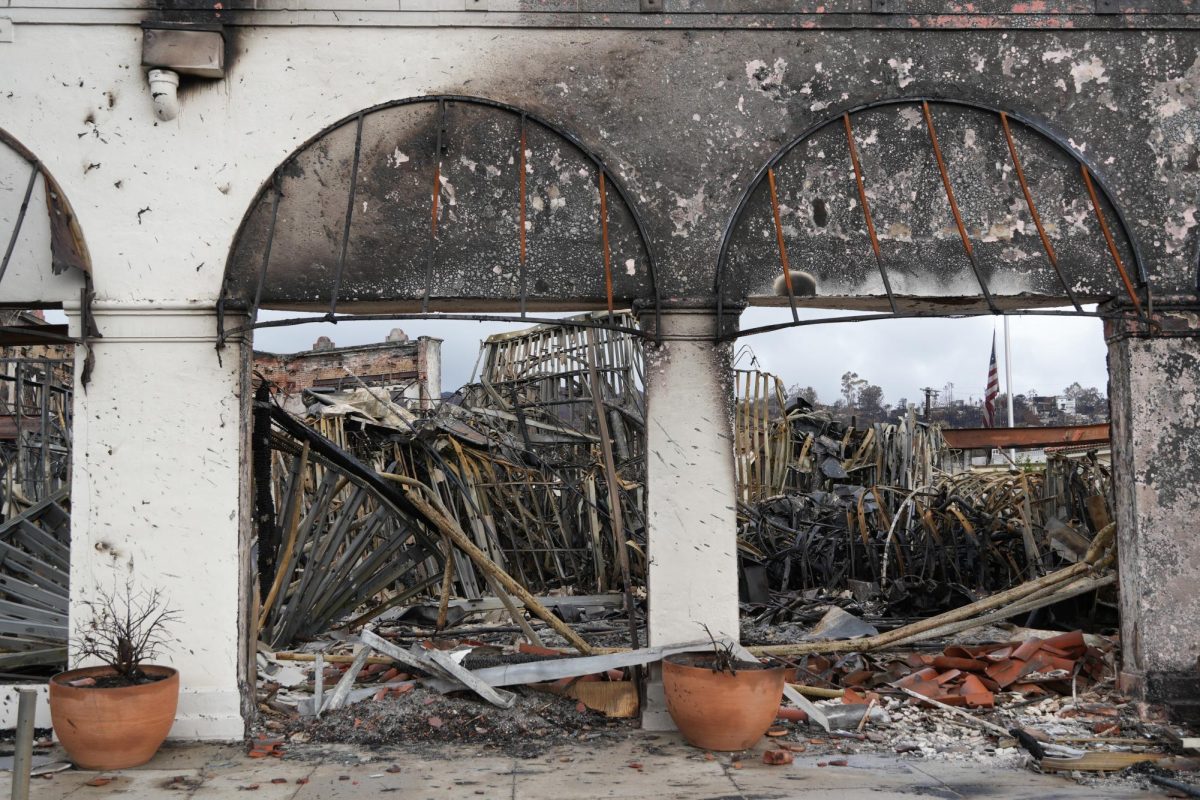
by Natalie ’16 and Alyce ’16
Updated from print
Air Force Commander Nicky Pearl ’04 says she had always dreamed of becoming an astronaut. During her senior year at Marlborough, she decided to pursue this dream by applying to the United States Air Force Academy, setting her on a different from all of her Marlborough classmates. When she arrived at the military academy, she showed up to classes primarily made-up of boys.
“I went from an all girls school to what was essentially an all boys school,” Pearl says.
Pearl currently serves as a Special Operations pilot and is a captain of a C-130, which is a military transport aircraft with a crew of eight. She is one of at least four Marlborough alumnae to serve in the military in the last 40 years, with Christina Bartzokis ’14 also currently in Naval Reserve Officer Training at Yale.
These alumnae will be be among the many Americans – men and women, soldiers and civilians – following the coming developments concerning the future of women in combat. In January of 2013, the Obama administration announced that it would open combat roles to women, and this coming January is the latest that branches of the military can announce and justify which positions they will keep closed to women.
The growing national debate about women in combat has highlighted the contributions of the hundreds of thousands of women already serving on active duty. Over 200,000 women are on active duty, according to the Department of Defense in January, and women make up just under 13% of the 71,400 service members currently deployed. With over 90,000 positions opened to women by the Army, Navy, Air Force and Marine Corps since 2013, 90% of military occupations are now open to women, but almost a quarter-million roles are still closed to women, according to the Government Accountability Office.
How do supporters and critics of integration think opening combat roles to women will impact units? How and why have Marlborough alumnae served in the military?
ALUMNAE IN THE MILITARY

Photo courtesy of Boyden Rohner ’95
Marlborough girls know there are Marlborough alumnae in board rooms and law offices across the country, but one place that Marlborough girls aren’t usually envisioned in is the military.
Among the Marlborough alumnae to go into military service are retired Naval Surface Warfare Officer Boyden Rohner ’95, Pearl and Bartzokis.
Bartzokis encountered preconceptions about the military when she applied to nROTC.
“Traditionally in academic environments like Marlborough, the military is considered kind of aiming too low in that people don’t see it as academically challenging or academically demanding” she says, adding that she disagrees with that assertion.
Sam ’16 who is the UltraViolet web and social media editor and wants to enter the military as a mechanic says the reactions from her Marlborough peers are typically confusion.
Despite the confusion and belief that the military isn’t academically rigorous, Bartzokis says that the Marlborough community was “generally supportive” of her decision to join nROTC.
Marlborough girls go into the military for reasons that range from academic interests to family ties.
Bartzokis became interested in the military from an academic perspective during her A.P. United States History class Marlborough.
“I didn’t feel right working in the military policy field without serving the military myself because I don’t think we should ask people to do something we wouldn’t be willing to do,” she said.
Rohner cited her familial influence as being a big factor in her decision to join the Navy. She wanted to pursue public service and saw the military as a way to do that.
Sam says her grandfather’s service and her desire to be a part of something bigger than herself have influenced her desire to become a mechanic in the military. As she got older, Sam’s reasons for wanting to join the military have changed.
“This whole idea of being part of something bigger than yourself and being part of the military was just so present in my mind because… [it]has always been something I’ve aimed for,” she says.
Both Pearl and Rohner have excelled in military life.
After graduating from the Air Force Academy Pearl enrolled in Pilot training, a military program that trains and prepares college graduates to fly in the US military. Pearl currently serves as a pilot in the Special Operations branch. She is a commander of a MC-130P, which is a military transport aircraft with a crew of eight.
While Rohner has served as the Fire Control and Combat Information Center Officer as well as a Training Officer on a guided military destroyer. She has also served in the Naval Reserves and currently works on Cyber Warfare for the Department of Homeland Security.
Rohner, Pearl and Bartzokis prove, entering the military after graduating from Marlborough isn’t impossible. Pearl gives advice for Marlborough’s future female officers.
“Don’t try to be one of the boys; be proud to be a woman because what you bring to the table and what your strengths are are unique,” Pearl says.
WOMEN IN COMBAT DEBATE
 Advocates of opening combat roles to women argue that women have already served in combat-like roles and clash with critics about how integrating women into combat would affect physical standards, unit cohesion and the prevalence of sexual assault in the military.
Advocates of opening combat roles to women argue that women have already served in combat-like roles and clash with critics about how integrating women into combat would affect physical standards, unit cohesion and the prevalence of sexual assault in the military.
Pearl and Rohner agree that female soldiers are capable of serving in combat.
“The way I was raised in Los Angeles with parents that were so supportive and going to Marlborough, I was raised to believe, quite rightly, that women can do anything men can do,” Pearl says. “I believe that to be true but there are a of people who don’t, and it’s been a really interesting discovery learning to interact with these people and work with them every day,” Pearl says.
Rohner emphasizes that women are already excelling in military service.
“I think there’s sort of no question that we can do all the jobs that we’re doing, flying planes, driving ships,” she says.
Army Captain Elizabeth Verardo, who served as an AH-64D Apache pilot and company commander and spoke in an interview with the UltraViolet, says it is important to understand that, even prior to the 2013 decision to lift the ban on women in combat was announced, women already served in combat-like capacities.
“Now it’s just a matter of waiting for the legislation to catch up with reality,” Verardo says.
Verardo, who is currently a candidate at Yale for a masters in global affairs, says combat roles should be integrated if women can meet the physical standards required for combat.
A Marine Corps study published in September found that all-male squads performed better than mixed-gender squads on its Infantry Officer School course.
Verardo says that lowering standards is something that must be weighed carefully, in considering both unit safety and the standing of female soldiers.
“I don’t think the right answer is to lower standards though because again I really don’t think that there’s a woman in this debate that will say that that’s the answer to gaining credibility,” Verardo says. “Especially in the military, so much of your credibility rests on your physical fitness.”
The Marine Corps study and the controversy over a People Magazine report that the female Ranger School graduates received special treatment in order to pass have raised doubts in some about women’s physical combat readiness.
Some opponents of combat integration say that unit effectiveness and safety is not just an issue of physical standards but unit cohesion. Explaining that military effectiveness comes down to the performance of the squad as a whole, retired Colonel Keith Nightingale wrote a Foreign Policy op-ed in September in which he congratulated the women who completed Ranger School but argued that infantry should be closed to women.
“Ranger School is first and foremost, an individual leadership school. It uses Infantry-type scenarios to achieve its purpose — but it’s all about the individual, not the unit….The squad and its dynamics ought to be the first priority versus its gender composition,” wrote Nightingale, who commanded four infantry companies, three battalions and two brigades during his military career.
The argument that integrating women will hurt unit cohesion holds little water with Rohner, Verardo, Sam and Bartzokis. Rohner was one of the first women to integrate the USS Arthur W. Radford.
“That argument was used about excluding women from the aviation community and ship driving…My commanding officer always said it increased the professionalism, so I don’t think it will have an adverse effect on unit cohesion,” Rohner says.
Concerns about the prevalence of sexual assault in the military have also factored into the debate about women in combat. Women in combat-like roles were far more likely to face sexual harassment or sexual harassment than other deployed women, according to an August 2013 study by Women’s Health Magazine.
Verardo says that sexual assault can be better combatted by unit leaders emphasizing respect and discipline than by keeping women out of combat.
“I just don’t know if I completely buy the arguments about women being there and it turning into these completely undisciplined units,” Verardo says, adding, “if you really want to stop sexual assault, then you need to stop this whole victimizing of women or somehow making them solely responsible just by their presence. I think it’s really dangerous.”
Bartzokis says opening combat roles to women will help decrease sexual assault by addressing a culture of inequality.
“I think that overall the fact that women can’t be integrated into combat roles feeds a culture that enables sexual assault because by saying that women are not qualified or not capable of serving in combat is essentially saying that they’re not equal and not as worthy of respect as men,” Bartzokis says.
***All opinions expressed by military personnel are personal opinions. They do not represent the official stance of the U.S. military.
Click here to read more.










